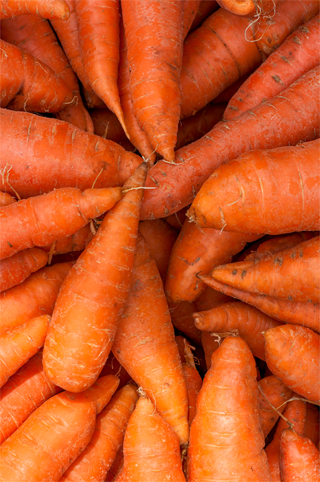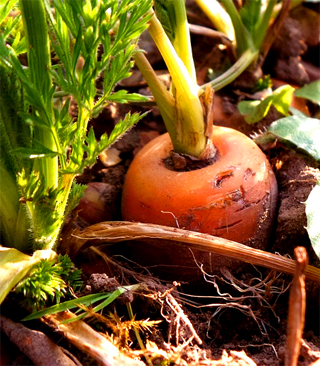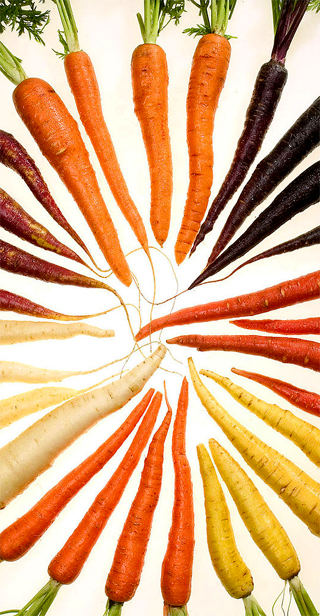
Growing the Best Carrots in Oregon, Washington and British Columbia.
Domestic carrots (Daucus carota) were developed hundreds of years ago from the plant we know as Queen Anne’s Lace. This wildflower originated in Europe and southwest Asia but is now commonly found throughout the Pacific Northwest. In fact, domestic types will cross-breed with their wild cousins if grown in close proximity. Carrots are also related to parsnips, fennel, parsley, cumin and dill.
The root of the carrot serves as a food storage unit during the plant’s first year. If allowed to continue its growth, the carrot will develop a seed stalk during its second year.
Standard varieties include short, fat, long, and thin types varying in disease tolerance, crispness, sweetness, and tenderness. Specialty types range in color from deep purple to beet red, yellow, white and even spotted. Large, coarse varieties are grown as livestock feed.
Carrots vary in maturation time from 60-90 days.
Carrots and Your Health
- A nutritional gold mine, carrots are high in vitamins A and C, and the B-complex group including folic acid, B-6, thiamin, and pantothenic acid. Wow!
- Antioxidants found in the orange veggies include Beta carotene and falcarinol, both of which fight free-radicals.
- Just one cup of raw carrots contains a whopping 113% of the Daily Value for vitamin A and 20% for biotin and vitamin K.
- In one study people who ate just one-quarter cup of carrots a day had a significantly lower risk of cardiovascular disease. Another study showed lower rates of glaucoma when carrots were eaten just twice a week.
- Carrots also made this list of the World’s Healthiest Foods.
- In addition to all those amazing nutrients, carrots have a number of necessary minerals including phosphorous, potassium, calcium, and copper.
Seasonal Guide
Spring
- Prep soil by adding sifted compost and sand.
- Direct sow as soon as soil can be worked.
- Sow successively every 2 weeks.
Summer
- Begin harvest of earliest carrots.
- Continue successive sowing until early July.
Fall
- Harvest remaining carrots.
- Plant a fall sowing in cloches if desired.
- In heavy soil, work in manure or compost to lighten loam for next year’s crop.
Winter
- Mulch over-wintering carrots (if planted outside cloche) with dried grass, straw or hay.
- Dig over-wintering carrots as needed.
Location
Carrots are not picky about location, but do need deep, rich soil for their long tap-roots.
Because they can be sown so early, it is helpful to plant with a windbreak on the east side of the rows (or whichever side would shield from predominant winds in your particular micro-climate.) Even a 6” plank standing on edge along that side of the row will reflect enough heat and light to protect the seedlings and speed germination, which can otherwise take up to two weeks.
Soil Prep
To grow smooth, straight carrots, soil must be finely tilled to a depth of 14”-16”. Fine soil allows the tiny seed to put down its tap root. Add a good amount of sifted, aged compost to keep soil loose and aerated. Lumps and coarse matter will cause knots and forking.
Work in a complete organic fertilizer, but avoid too much nitrogen, which causes forked and hairy roots. Fresh manure will cause the same problem.
Avoid digging wet soil which will form clods and interfere with straight growth.
Also, avoid compacting the bed by stepping on it: planting in raised beds will help prevent this.
Planting
Direct sow seeds in a ½” deep trench. Space rows 18”apart.
Carrot seed is tiny and thinning is extra important for well-formed roots so try this trick to get just the right spacing:
- Mix 1/4 teaspoon of seed with one gallon of sand, potting soil or sifted compost.
- Dig a trench and spread your mixture evenly along the bottom. 1/4 teaspoon should sow about 40′ of row.
- Next cover the seed with a little more compost and keep the soil moist.
Many gardeners also mix the tiny carrot seeds with radish seeds which will emerge quickly, marking the row, and aid in spacing as they are pulled.
It is very important to prevent the soil from crusting over the seeds and hampering emergence, so water gently before covering. After watering in, cover the small seeds with potting soil or a light mix of soil and sifted compost.
Thin to 2”-3” apart. Weed when very small, as carrots are slow starters and will be unable to compete with weeds for some time.
Water
Water regularly, keeping the soil evenly moist. If allowed to dry out, the carrots will split and crack when they are watered.
Harvest
Pull carrots beginning when they are finger-size. They’ll come up more easily if pushed gently downward first, breaking the root hairs, and then pulled up. If soil has hardened, dig with a trowel, shovel or spading fork. Late-season sowings will over-winter in the PNW with a protective cloche or in the open if winter is mild.
Insects and Diseases
The carrot rust fly is a warm-weather pest, usually showing up in mid-summer to lay its eggs at the base of carrot leaves. The fly larva hatch and burrow into the roots. Well-limed soil will usually prevent the rust fly, but you can also cover seedlings with floating row cover to prevent infestation. Crop rotation will also help prevent soil infestation.



